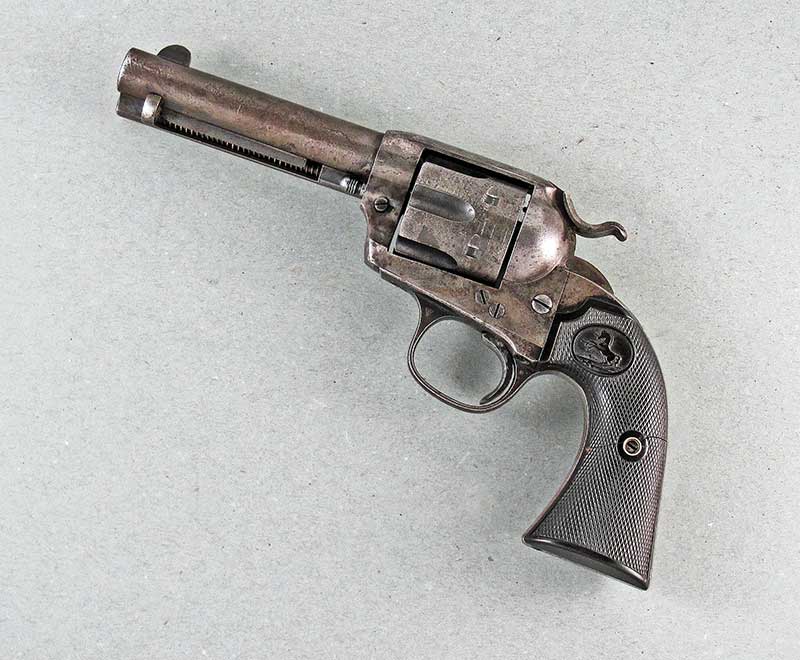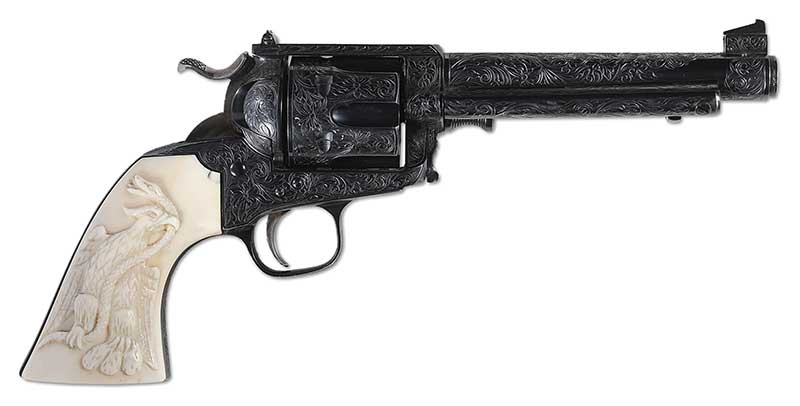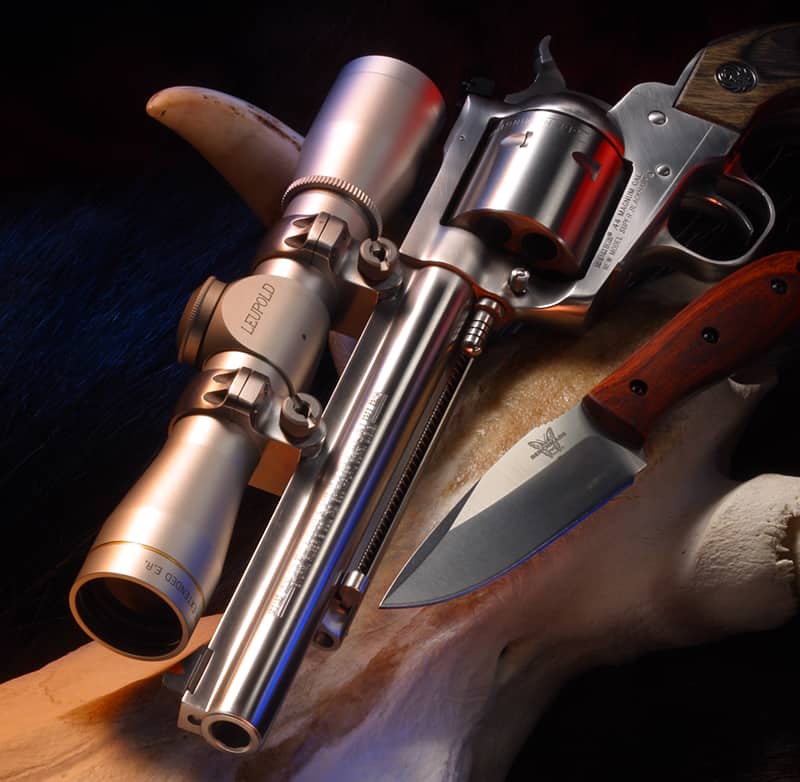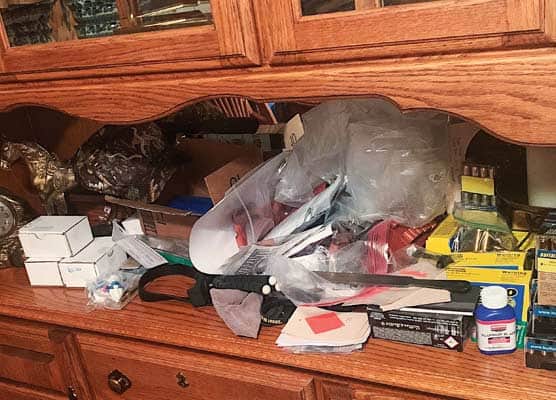Birth Of The Bisley
A Great Single Action From Yesterday Through Today
The Colt Single Action Army, which arrived in 1873, is unarguably the best-balanced sixgun ever offered when outfitted with the 4 3/4″ barrel and chambered in .45 or .44. It points naturally and, in proper hands and from a proper holster, is still the fastest sixgun for the first shot.
By the 1890s the West had pretty much been tamed and shooters started looking toward more activities in the area of recreation. Target shooting was becoming very popular and Colt tried their best to address this with the Single Action Army by turning it into the Flat-Top Target revolver. It had a flat-topped frame with adjustable sights, which while crude were certainly better than the standard sights found on the Colt Single Action Army.
Coming To Grips
The grip frame of the SAA was very kind to the hands when firing standard loads, with the sixgun rotating gently backward in the hand and positioning the thumb for cocking the hammer for a fast second shot. However, target shooters needed a grip that would move less under recoil. Several changes were made to the standard Flat-Top Target to accomplish this. The area of the grip frame behind the triggerguard was raised higher to allow the grip to sit deeper in the hand while the backstrap was raised much higher to prevent the entire sixgun from rocking backward under recoil. The hammer profile was changed to a wide target-style and lowered for easier reach while the trigger was widened to afford the feel of a lighter trigger pull.
The Bisley Model, as this version became known, was named after the English town of Bisley where international target matches were held. It may have been designed as a target pistol, but enough shooters wanted a standard version that Colt brought out the Bisley Model with the same hog wallow trough rear sight in the top of the mainframe and the standard front sight found on the Single Action Army. Less than 1,000 Bisley Flat-Top Target Model guns were produced while more than 44,000 standard model Bisleys came forth.
By 1912 sales of the Colt Single Action Army in general were on the decline, and the Bisley was dropped from the Colt catalog. For the next several years, Bisleys would still be produced from inventory parts on-hand.
Elmer Keith’s Take
Renowned expert and shooter Elmer Keith wasn’t satisfied with stock factory sixguns and enlisted the help of some of the top gunsmiths and engravers in the country of his era to customize his sixguns. On page 103 of Keith’s classic book Sixguns, there’s a picture of four beautiful Colt Single Actions, all of which I’ve been privileged to handle.
Keith’s four Colt Single Action .44 Specials were a King short-action job, 7 1/2″ barrel; an original, one of a kind 7 1/2″ Flat-Top Target; a 5 1/2″ Flat-Top Target with a Keith-designed folding three leaf rear sight and an extensively customized 5 1/2″ Flat-Top Target with a special grip frame by gunsmith Harold Croft in 1929.
Keith had the top strap of a standard Colt Single Action welded to make a heavy Flat-Top Target design. The old flat mainspring was replaced by a U-type spring, and the hammer was made by welding a Bisley wide hammer on a standard hammer. The rear sight is adjustable and the front sight is the high Patridge type. The base pin latch was changed to eliminate any chance of the pin jumping forward under recoil, and the grip frame was a mated standard Colt SAA triggerguard and a Bisley backstrap. The gun was fully engraved with ivory stocks. He called it the “No. 5.”
Keith would say before this gun was built he was done with the .45 Colt so the chambering was .44 Special. He felt he could safely load much heavier loads with the .44 Special and the resulting thicker chamber walls in the Colt Single Action.
Ruger’s Bisley Model
Bill Ruger first started producing his version of the Bisley Model in the mid-1980s. The large-frame Bisleys were chambered in .45 Colt, .44 Magnum, .41 Magnum and .357 Magnum. Single-Six versions have been offered in .22/.22 Magnum, .32 Magnum and .327 Magnum, and with the coming of the .44 Special, a New Model Flat-Top was also offered in this classic cartridge. In 2015 Ruger brought out a five-shot Bisley Model in a choice of .454 or .480 Ruger. Without the Bisley grip frame these two cartridges would be very difficult to handle for most mere mortals.
The Ruger Bisleys have proven themselves to be well built and strong, and good-shooting sixguns. The Bisley has become the choice of custom gunsmiths, beginning with John Linebaugh, for fitting with five-shot .475 and .500 Linebaugh cylinders and barrels. It’s chosen for its inherent strength, and comfortable grip frame. With full-house loads all of these really big-bore cartridges would be much more painful without the Ruger Bisley Model grip frame.
Like so many others, I erroneously reported the Ruger Bisley grip frame was a copy of the old No. 5 SAA grip made for Elmer Keith by Croft in 1929. After handling the original No. 5 SAA I found the grip to be quite a bit smaller than the Ruger Bisley grip. Keith had small hands and the original grip was made accordingly. The Ruger Bisley was inspired by the No. 5, but it’s not a copy of it.
Custom Bisleys
From time immemorial, well at least since I was a teenage budding sixgunner, I preferred the 7 1/2″ barrel length on my single actions. As I’ve gotten older I’ve moderated somewhat and now find the 5 1/2″ length a good compromise between the longer barrel and the easier packing 4 3/4″. All three of my original big-bore Bisleys in .45 Colt, .41 Magnum and .44 Magnum were sent to Ben Forkin. He shortened the barrels to 5 1/2″, tuned the actions, installed new front sights and refinished them — including frames and hammers case-colored by Doug Turnbull. They are now beautifully crafted Perfect Packin’ Pistols.
Ruger Bisley Models have not only been offered by Ruger over the years in several variations, including a Hunter Model set up for easy scope mounting, but also from time to time as stainless steel Bisley Models in easy packin’ barrel lengths. Over the years I have had custom sixguns built with Bisley Model grip frames not just by Ben Forkin, but also David Clements, Andy Horvath, Alan Harton, Milt Morrison, Jim Stroh and my original .500 Linebaugh by John Linebaugh. Diamond Dot ordered a special custom Bisley Model .44 Special from Gary Reeder for my birthday 15 years ago. It’s a cherished sixgun to be passed down to one of the grandkids someday.
I recently spoke at the initial gathering of a new men’s group with 250 in attendance. They presented me with a custom .44 Special Bisley Model Ruger put together by Buckhorn Gun. They couldn’t have come up with a better token of appreciation. I’ve loved Bisleys for as long as I can remember, and I know a lot of other shooters have as well. *
For more info:

Get More Revolver Content Every Week!
Sign up for the Wheelgun Wednesday newsletter here:









